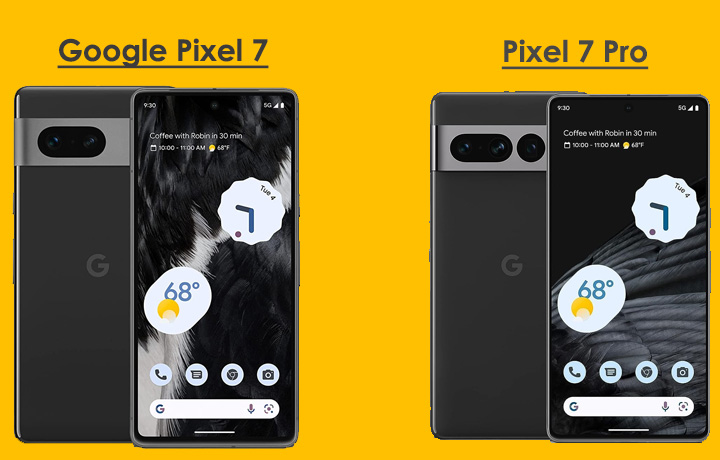As the smartphone landscape continues to evolve, Google’s latest offerings, the Google Pixel 7 and 7 Pro, shine brightly as two of the standout releases this year. Their striking similarities in features make it a challenging decision to choose between them.
In this review, Miranda from Android Authority takes us through an in-depth comparison of the Pixel 7 and Pixel 7 Pro, helping you navigate the choice between these formidable devices.
- Check out these as well:
- Google Pixel 7A Review
- Samsung Galaxy Tab S9 Ultra vs. Galaxy Tab S8 Ultra
- Google Pixel 7A Vs. Galaxy A54
Design: Refinements That Matter
The design evolution of the Pixel 7 series exhibits subtle yet impactful changes from its predecessors. The aluminum camera bar is an elegant touch on both models, although the matte finish of the Pixel 7 trumps the polished appearance of the Pixel 7 Pro.
The latter’s polished look unfortunately attracts fingerprints, somewhat diminishing its allure. The Pixel 7’s lighter weight, achieved by a slightly smaller display and battery, contrasts with the Pixel 7 Pro’s unchanged heft. These refinements demonstrate Google’s commitment to ergonomic improvements.
Display: Where the Pro Shines
While design similarities abound, the display quality takes a noteworthy divergence. The Pixel 7 boasts a respectable 6.3-inch 1080p AMOLED panel with a 90 Hz refresh rate and peak brightness of 1400 nits. However, the Pixel 7 Pro offers a grander 6.7-inch 1440p AMOLED panel, a 120 Hz refresh rate, and a stunning peak brightness of 1500 nits.
LTPO display technology is exclusive to the Pixel 7 Pro, theoretically enhancing battery life. Regardless of choice, both displays exhibit sharpness, color vibrancy, and sunlight visibility. The Pixel 7 Pro emerges as the victor on paper but both options impress.
Performance: Tensor-Powered Excellence
Google’s Tensor G2 processor propels both phones, resulting in fluid day-to-day operations. Social media, texting, photography, and even light gaming are executed effortlessly on both the Pixel 7 and 7 Pro. The upgraded Tensor Processing Unit brings accelerated machine learning capabilities, enriching features such as Nightside photos and cinematic blur effects.
The enhanced modem rectifies previous reception issues, bolstering both performance and battery life. The slight disparity in RAM – 8GB for Pixel 7, 12GB for Pixel 7 Pro – doesn’t significantly impact daily use, but the latter does hold the edge in benchmarks.
- Shop On Amazon Using Our Links To Support Us:
- Amazon under $25:
- Amazon best sellers:
- Amazon most gifted:
Battery Life: Pro’s Superior Stamina
Battery life emerges as a pivotal distinction between the two models. The Pixel 7 is armed with a 4355 mAh battery, sufficient for a day’s use, while the Pixel 7 Pro houses a 5000 mAh battery that readily extends into a day and a half.
The Pixel 7’s efficiency improvements attributed to the Tensor G2 ensure its reliability. For exceptional longevity, the Pixel 7 Pro introduces an “Extreme Battery Saver” mode that can stretch the usage up to 72 hours – a handy feature for power users.
Camera: The Pro’s Photographic Edge
The camera systems on both models, featuring a 50 MP main sensor and 12 MP ultra-wide lens, produce impressive results. However, the Pixel 7 Pro takes the lead with a dedicated 48 MP telephoto shooter boasting optical and digital zoom capabilities.
The telephoto lens enables stunning portraits and detailed close-ups, a distinct advantage over the Pixel 7’s cropping method. Google’s super resolution technology attempts to bridge the gap, but the Pro’s specialized hardware prevails. The Pro also excels with a macro mode through the auto-focus equipped ultra-wide lens, a feature the Pixel 7 lacks.
Configurations, Colors, and Pricing: Your Choice
Choosing between the Pixel 7 and Pixel 7 Pro isn’t just about performance; it’s about finding the best fit for your needs and budget. The Pixel 7 starts at $599 with 8 GB of RAM and 128 GB of storage, expandable for an additional fee.
The Pixel 7 Pro’s base model starts at $899 with 12 GB of RAM and 128 GB of storage. Both models offer various colorways to match your style.
Verdict: Pro for Professionals, 7 for Value
In conclusion, Miranda’s recommendation aligns with individual priorities. The Pixel 7 presents a compelling case, offering near-flagship performance, premium design, top-tier camera capabilities, and a clean user interface for a remarkable price of $599.
On the other hand, the Pixel 7 Pro, priced at $899, excels in battery life, camera versatility, and a larger screen, making it an appealing option for photography enthusiasts, heavy users, and those who relish a more immersive visual experience.
Whichever you choose, Google’s Pixel 7 series brings outstanding value to the table, solidifying their position as some of the year’s most notable smartphones.







